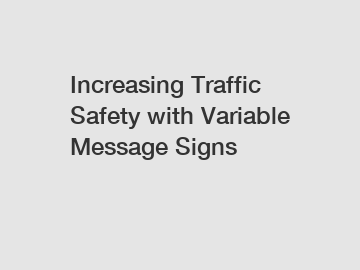Increasing Traffic Safety with Variable Message Signs
Increasing Traffic Safety with Variable Message Signs.
Variable message signs (VMS) have been proven to be an effective tool in improving traffic safety. These signs, also known as electronic message signs or dynamic message signs, can display real-time information to drivers, alerting them to potential hazards and providing guidance for better traffic management. This article aims to explore the reasons behind the positive impact of VMS on traffic safety, the evidence supporting their effectiveness, and the significance and implications of their wider adoption.
The use of VMS in traffic management has significantly increased in recent years due to their ability to convey important information to drivers in a clear and concise manner. These signs can display a wide range of messages, including traffic congestion warnings, speed limit notifications, and weather-related updates, among others. By providing real-time information, VMS enable drivers to make better decisions, adjust their driving behaviors, and avoid potential accidents.

Various studies have shown the positive effects of VMS on traffic safety. For instance, a study conducted by the Australian Road Research Board found that the use of VMS resulted in a 25% reduction in crashes and a 30% decrease in severe injuries. Similarly, research conducted in the Netherlands demonstrated that the implementation of VMS led to a 20% reduction in traffic congestion and a subsequent decrease in accidents.
The effectiveness of VMS can be attributed to several factors. Firstly, their ability to display real-time information allows drivers to be aware of current road conditions and adjust their behavior accordingly. For example, if a VMS displays a message warning of heavy traffic ahead, drivers can choose alternative routes or slow down, reducing the likelihood of rear-end collisions. Secondly, VMS can also be programmed to provide specific instructions, such as speed limit reductions in construction zones, contributing to a safer driving environment. Lastly, the visibility of VMS, particularly at night or in adverse weather conditions, ensures that messages are easily seen by drivers, enhancing their effectiveness in promoting safer driving practices.
The wider adoption of VMS has significant implications for traffic safety. Firstly, it can contribute to a reduction in traffic-related injuries and fatalities. By providing timely information and guidance, VMS help create a safer driving environment and reduce the likelihood of accidents. Secondly, VMS can also contribute to the efficiency of traffic flow by minimizing congestion and improving overall traffic management. This is particularly crucial in urban areas where traffic density is high. Additionally, improved traffic flow reduces the frustration and stress experienced by drivers, leading to a more pleasant and safer driving experience.
In conclusion, variable message signs play a crucial role in increasing traffic safety. Their ability to provide real-time information, specific instructions, and enhanced visibility makes them an effective tool for promoting safer driving practices and reducing accidents. The evidence from various studies supports their effectiveness, and their wider adoption has the potential to significantly improve traffic safety and enhance overall traffic management. It is imperative for authorities and policymakers to recognize the importance of VMS and invest in their implementation as part of a comprehensive approach to improving road safety.
For more information, please visit low power consumption led variable message sign, led variable message signs, customized 100w led high bay light.
149
0
0


Comments
All Comments (0)